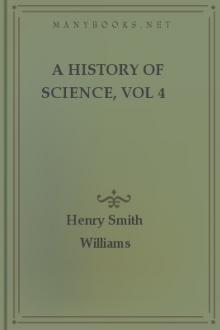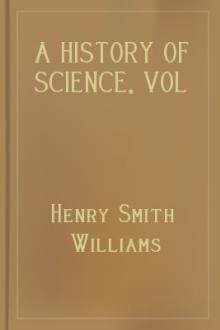A History of Science, vol 2, Henry Smith Williams [read this if txt] 📗

- Author: Henry Smith Williams
- Performer: -
Book online «A History of Science, vol 2, Henry Smith Williams [read this if txt] 📗». Author Henry Smith Williams
He performed a most interesting experiment with his sulphur globe and a feather, and in doing so came near anticipating Benjamin Franklin in his discovery of the effects of pointed conductors in drawing off the discharge. Having revolved and stroked his globe until it repelled a bit of down, he removed the globe from its rack and advancing it towards the now repellent down, drove it before him about the room. In this chase he observed that the down preferred to alight against “the points of any object whatsoever.” He noticed that should the down chance to be driven within a few inches of a lighted candle, its attitude towards the globe suddenly changed, and instead of running away from it, it now “flew to it for protection” —the charge on the down having been dissipated by the hot air. He also noted that if one face of a feather had been first attracted and then repelled by the sulphur ball, that the surface so affected was always turned towards the globe; so that if the positions of the two were reversed, the sides of the feather reversed also.
Still another important discovery, that of electrical conduction, was made by Von Guericke. Until his discovery no one had observed the transference of electricity from one body to another, although Gilbert had some time before noted that a rod rendered magnetic at one end became so at the other. Von Guericke’s experiments were made upon a linen thread with his sulphur globe, which, he says, “having been previously excited by rubbing, can exercise likewise its virtue through a linen thread an ell or more long, and there attract something.” But this discovery, and his equally important one that the sulphur ball becomes luminous when rubbed, were practically forgotten until again brought to notice by the discoveries of Francis Hauksbee and Stephen Gray early in the eighteenth century. From this we may gather that Von Guericke himself did not realize the import of his discoveries, for otherwise he would certainly have carried his investigations still further. But as it was he turned his attention to other fields of research.
ROBERT HOOKE
A slender, crooked, shrivelled-limbed, cantankerous little man, with dishevelled hair and haggard countenance, bad-tempered and irritable, penurious and dishonest, at least in his claims for priority in discoveries—this is the picture usually drawn, alike by friends and enemies, of Robert Hooke (1635-1703), a man with an almost unparalleled genius for scientific discoveries in almost all branches of science. History gives few examples so striking of a man whose really great achievements in science would alone have made his name immortal, and yet who had the pusillanimous spirit of a charlatan—an almost insane mania, as it seems—for claiming the credit of discoveries made by others.
This attitude of mind can hardly be explained except as a mania: it is certainly more charitable so to regard it. For his own discoveries and inventions were so numerous that a few more or less would hardly have added to his fame, as his reputation as a philosopher was well established. Admiration for his ability and his philosophical knowledge must always be marred by the recollection of his arrogant claims to the discoveries of other philosophers.
It seems pretty definitely determined that Hooke should be credited with the invention of the balance-spring for regulating watches; but for a long time a heated controversy was waged between Hooke and Huygens as to who was the real inventor. It appears that Hooke conceived the idea of the balance-spring, while to Huygens belongs the credit of having adapted the COILED
spring in a working model. He thus made practical Hooke’s conception, which is without value except as applied by the coiled spring; but, nevertheless, the inventor, as well as the perfector, should receive credit. In this controversy, unlike many others, the blame cannot be laid at Hooke’s door.
Hooke was the first curator of the Royal Society, and when anything was to be investigated, usually invented the mechanical devices for doing so. Astronomical apparatus, instruments for measuring specific weights, clocks and chronometers, methods of measuring the velocity of falling bodies, freezing and boiling points, strength of gunpowder, magnetic instruments—in short, all kinds of ingenious mechanical devices in all branches of science and mechanics. It was he who made the famous air-pump of Robert Boyle, based on Boyle’s plans. Incidentally, Hooke claimed to be the inventor of the first air-pump himself, although this claim is now entirely discredited.
Within a period of two years he devised no less than thirty different methods of flying, all of which, of course, came to nothing, but go to show the fertile imagination of the man, and his tireless energy. He experimented with electricity and made some novel suggestions upon the difference between the electric spark and the glow, although on the whole his contributions in this field are unimportant. He also first pointed out that the motions of the heavenly bodies must be looked upon as a mechanical problem, and was almost within grasping distance of the exact theory of gravitation, himself originating the idea of making use of the pendulum in measuring gravity. Likewise, he first proposed the wave theory of light; although it was Huygens who established it on its present foundation.
Hooke published, among other things, a book of plates and descriptions of his Microscopical Observations, which gives an idea of the advance that had already been made in microscopy in his time. Two of these plates are given here, which, even in this age of microscopy, are both interesting and instructive. These plates are made from prints of Hooke’s original copper plates, and show that excellent lenses were made even at that time. They illustrate, also, how much might have been accomplished in the field of medicine if more attention had been given to microscopy by physicians. Even a century later, had physicians made better use of their microscopes, they could hardly have overlooked such an easily found parasite as the itch mite, which is quite as easily detected as the cheese mite, pictured in Hooke’s book.
In justice to Hooke, and in extenuation of his otherwise inexcusable peculiarities of mind, it should be remembered that for many years he suffered from a painful and wasting disease.
This may have affected his mental equilibrium, without appreciably affecting his ingenuity. In his own time this condition would hardly have been considered a disease; but to-day, with our advanced ideas as to mental diseases, we should be more inclined to ascribe his unfortunate attitude of mind to a pathological condition, rather than to any manifestation of normal mentality. From this point of view his mental deformity seems not unlike that of Cavendish’s, later, except that in the case of Cavendish it manifested itself as an abnormal sensitiveness instead of an abnormal irritability.
CHRISTIAN HUYGENS
If for nothing else, the world is indebted to the man who invented the pendulum clock, Christian Huygens (1629-1695), of the Hague, inventor, mathematician, mechanician, astronomer, and physicist. Huygens was the descendant of a noble and distinguished family, his father, Sir Constantine Huygens, being a well-known poet and diplomatist. Early in life young Huygens began his career in the legal profession, completing his education in the juridical school at Breda; but his taste for mathematics soon led him to neglect his legal studies, and his aptitude for scientific researches was so marked that Descartes predicted great things of him even while he was a mere tyro in the field of scientific investigation.
One of his first endeavors in science was to attempt an improvement of the telescope. Reflecting upon the process of making lenses then in vogue, young Huygens and his brother Constantine attempted a new method of grinding and polishing, whereby they overcame a great deal of the spherical and chromatic aberration. With this new telescope a much clearer field of vision was obtained, so much so that Huygens was able to detect, among other things, a hitherto unknown satellite of Saturn. It was these astronomical researches that led him to apply the pendulum to regulate the movements of clocks. The need for some more exact method of measuring time in his observations of the stars was keenly felt by the young astronomer, and after several experiments along different lines, Huygens hit upon the use of a swinging weight; and in 1656 made his invention of the pendulum clock. The year following, his clock was presented to the states-general. Accuracy as to time is absolutely essential in astronomy, but until the invention of Huygens’s clock there was no precise, nor even approximately precise, means of measuring short intervals.
Huygens was one of the first to adapt the micrometer to the telescope—a mechanical device on which all the nice determination of minute distances depends. He also took up the controversy against Hooke as to the superiority of telescopic over plain sights to quadrants, Hooke contending in favor of the plain. In this controversy, the subject of which attracted wide attention, Huygens was completely victorious; and Hooke, being unable to refute Huygens’s arguments, exhibited such irritability that he increased his already general unpopularity. All of the arguments for and against the telescope sight are too numerous to be given here. In contending in its favor Huygens pointed out that the unaided eye is unable to appreciate an angular space in the sky less than about thirty seconds. Even in the best quadrant with a plain sight, therefore, the altitude must be uncertain by that quantity. If in place of the plain sight a telescope is substituted, even if it magnify only thirty times, it will enable the observer to fix the position to one second, with progressively increased accuracy as the magnifying power of the telescope is increased. This was only one of the many telling arguments advanced by Huygens.
In the field of optics, also, Huygens has added considerably to science, and his work, Dioptrics, is said to have been a favorite book with Newton. During the later part of his life, however, Huygens again devoted himself to inventing and constructing telescopes, grinding the lenses, and devising, if not actually making, the frame for holding them. These telescopes were of enormous lengths, three of his object-glasses, now in possession of the Royal Society, being of 123, 180, and 210 feet focal length respectively. Such instruments, if constructed in the ordinary form of the long tube, were very unmanageable, and to obviate this Huygens adopted the plan of dispensing with the tube altogether, mounting his lenses on long poles manipulated by machinery. Even these were unwieldy enough, but the difficulties of manipulation were fully compensated by the results obtained.
It had been discovered, among other things, that in oblique refraction light is separated into colors. Therefore, any small portion of the convex lens of the telescope, being a prism, the rays proceed to the focus, separated into prismatic colors, which make the image thus formed edged with a fringe of color and indistinct. But, fortunately for the early telescope makers, the degree of this aberration is independent of the focal length of the lens; so that, by increasing





Comments (0)